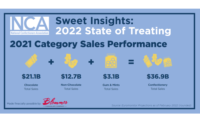The outlook is good for the U.S. chocolate candy market.
According to a new report by market research publisher Packaged Facts, the future of the market is bullish, with chocolate sales in the United States expected to exceed $26 billion by the 2018. That's up from the $22 billion in sales estimated by the end of 2015.
With 81 percent of American consumers eating chocolate, that's no surprise.
The chocolate category is dynamic. Innovation plays a key role in the market. The quick pace of innovation combined with new creative players and a steady flow of new products makes it easy to engage and retain consumers.
The chocolate market faces its own set of challenges, but they haven't prevented the segment from continuing to grow. In the short-term, the supply of cocoa is limited. There's also public concern about cocoa farming processes.
But those challenges are outweighed by several factors that help boost the chocolate segment's growth. Consumers are, evidently, devoted to the product. Despite the economic climate, consumers continue to spend on chocolate and allow it to grow. Chocolate is also increasingly perceived as an accessible luxury, creating opportunities to trade consumers up to premium products.
It helps that research also supports cocoa as a superfood containing many nutritional benefits. These findings both enhance the image of chocolate as a guilt-free indulgence and drive consumption.
The market is also special in that big and small companies alike are able to compete. Although there are giants like Hershey and Mars that dominate much of the segment, there are still plenty of opportunities for smaller, innovative chocolate makers to find an audience and make their mark.
Published in Chocolate Candy in the U.S., 10th Edition, the Packaged Facts report examines market sizes, data, and product trends to provide forecasts through the next three years.
And so far, it looks like the chocolate market is in a sweet spot.










